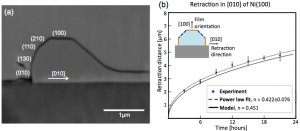Quantitative Analysis and Modeling of Templated Solid-state Dewetting of Thin Single-crystal Ni Films
- Category: Materials
- Tags: carl thompson, kathleen fitzgerald
Thin films are generally metastable in the as-deposited state and will dewet (agglomerate) when heated. Nanometer scale films (<100 nm thick) can dewet at temperatures well below the melting temperature of the film, and dewetting occurs while the film remains solid. This phenomenon can limit the use of very thin films in microsystems, but it can also be used to controllably produce complex structures[1]. Dewetting occurs through retraction of the edges of naturally forming holes or at patterned edges of films. In single crystal films, anisotropy in surface energy and diffusivity drives the dewetting process to result in regular patterns that relate to the crystal symmetry. We are investigating use of anisotropic dewetting as a self-assembly method to generate complex, small, predetermined patterns. A quantitative understanding of dewetting mechanisms is critical for design of self-assembled structures made through dewetting. We measured the rates of anisotropic edge retraction by solid-state dewetting in kinetically stable edge orientations. These measurements can also be used to estimate the edge retraction rates in a general crystallographic orientation[2]. Additionally, an analytical model for solid-state dewetting via surface diffusion for fully faceted materials has been developed to test our understanding of dewetting mechanisms (Figure 1). This two-dimensional model provides excellent agreement with experimental edge retraction rates for kinetically stable edges[3]. We also developed a three-dimensional phase-field model for dewetting of materials with isotropic surface energies[4]. A three-dimensional model for dewetting of materials with anisotropic surface energies is under development.
- Figure 1: (a) Partially dewetted patches patterned from a (100) film into squares with different in-plane orientations; top is an earlier time than bottom. (b) Dewetting patterns of larger squares[5].
- Figure 2: (a) Cross-sectional SEM image of a [010] edge in a (100) film. (b) Corresponding experimental and theoretical retraction distance vs. time[6],[7].
- J. P. Ye and C. V. Thompson, “Templated solid state dewetting to controllably produce complex patterns,” Advanced Materials, vol. 23, pp. 1567-1571, 2011. [↩]
- G. H. Kim, R. V. Zucker, W. C. Carter, and C. V. Thompson, “Quantitative analysis of anisotropic edge retraction by solid-state dewetting of thin single crystal films,” Journal of Applied Physics, vol. 113, 043512, 2013. [↩]
- R. V. Zucker, G. H. Kim, W. C. Carter, C. V. Thompson, “A model for solid state dewetting of a fully faceted thin film,” C. R. Phys. (to be published). [↩]
- W. Jiang, W. Bao, C. V. Thompson, and D. J. Srolovitz, “Phase Field Approach for Simulating Solid-State Dewetting Problems,” Acta Materialia 60, 5578–5592 (2012). [↩]
- G.. H. Kim, R. V. Zucker, W. C. Carter, and C. V. Thompson, “Quantitative analysis of anisotropic edge retraction by solid-state dewetting of thin single crystal films,” Journal of Applied Physics, vol. 113, 043512, 2013. [↩]
- R. V. Zucker, G. H. Kim, W. C. Carter, C. V. Thompson, “A model for solid state dewetting of a fully faceted thin film,” C. R. Phys. (to be published). [↩]
- W. Jiang, W. Bao, C. V. Thompson, and D. J. Srolovitz, “Phase Field Approach for Simulating Solid-State Dewetting Problems,” Acta Materialia 60, 5578–5592 (2012). [↩]

